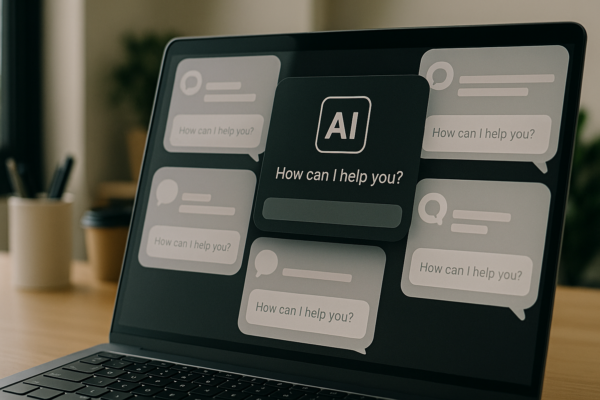AI is reshaping how work gets done, and AI in HR is no exception. From onboarding to offboarding, performance reviews to policy updates, artificial intelligence is changing the way HR teams operate. But to lead this shift, HR needs more than tools. It needs a mindset shift.
HR teams are uniquely positioned in this transition, not just to adopt AI, but to guide the entire organization through it. From recruiting to retention, from policy to performance, AI is already influencing every touchpoint. But to lead this shift, HR has to go first.
What Is an AI-First Mindset for HR?
An AI-first mindset doesn’t mean replacing people. It means:
- Seeing AI as a partner in delivering better employee experiences, not just a tool to cut costs.
- Using AI to augment empathy, not automate it.
- Reimagining workflows, from onboarding and internal mobility to policy updates and employee communication, with intelligence built in.
Ask yourself: What could your HR team accomplish if it weren’t buried in clerical work?
What Does “AI in HR” Really Mean?
AI in HR refers to the use of artificial intelligence tools and systems to streamline HR tasks, make better data-driven decisions, and improve the employee experience. From automation to personalization, AI is no longer optional. It’s becoming a core capability for modern HR teams.
Why Adopting AI Matters Now More Than Ever
- 1 in 3 HR leaders say AI has already changed how they work (Gartner, 2023)
- 86% of employees want transparency around how AI is being used in HR (LinkedIn Workplace Learning Report)
- Talent teams using AI are 2x more likely to hit hiring targets while reducing time-to-fill (Eightfold, 2024)
The shift is happening with or without you. HR leaders who lean in now have the chance to not just adapt, but lead.
5 Ways HR Teams Can Go AI-First (Starting Now)
1. Use AI in HR Daily
You can’t coach what you don’t practice, and if HR wants to lead in the age of AI, it has to start by building fluency inside its own function. Using AI daily helps build confidence, uncover use cases, and model the kind of experimentation you want the rest of the company to follow.
You don’t need a massive transformation to get started. Try small, tangible tasks:
- Draft a job description using AI (try Winslow’s Job Description Generator)
- Summarize employee survey responses for leadership
- Rewrite an outdated policy for clarity and tone
If you want to lead with AI in HR, it starts with using the tools yourself. Daily practice turns theory into muscle memory—and puts you in a stronger position to evaluate tools and lead change across the org.
2. Apply Smart Constraints
AI is powerful, but unfocused ambition leads to burnout. Smart constraints are how you aim that power. The best HR teams we work with set specific goals that stretch the team without overwhelming them.
Think of it like this: don’t try to automate everything. Instead, choose a measurable problem where AI can help you do more with less.
Examples:
- Improve internal response time by 50% by routing employee questions through an AI assistant
- Increase recruiting outreach without increasing recruiter workload by using AI to personalize first messages at scale
Constraints force clarity. AI turns that clarity into output. When you set the right boundaries, you unlock creativity and efficiency.
3. Pick One Project and Learn From It
Theory doesn’t build capability—real projects do. The fastest way to build confidence and uncover blockers is by taking one AI initiative end-to-end.
Choose a project with a clear problem, high repetition, and access to clean data. You don’t need a moonshot, just a place to learn.
Popular starting points we’ve seen:
- Automate part of your recruiting workflow (e.g. resume summaries, outreach messages, or interview scheduling)
- Set up an internal HR assistant to answer policy questions from employees using your real handbook and systems
When you go through a full cycle—from identifying the problem to deploying a solution—you expose real-world friction: security reviews, integration pain, and change management. That’s valuable insight for future scale.
👉 Tip: Winslow’s free HR assistant is a great place to experiment without a heavy lift. You can schedule time with us here to setup your account.
4. Be Publicly Curious
Change is contagious. But only if people can see it. When HR teams try things quietly in the background, they miss a chance to shape culture. Being publicly curious means sharing what you’re trying, what you’re learning, and what you don’t know yet.
This creates permission across the org to do the same. It lowers the pressure for perfection and increases engagement.
Ideas:
- Host a “What we’re learning about AI” session for your team or company
- Share one small AI experiment every Friday in your internal newsletter or Slack channel
- Partner with a few early adopters on your team and spotlight what they tried
Transparency drives adoption. Vulnerability builds trust. Both are key to cultural change.
5. Track and Celebrate Progress
If you’re going to invest in AI, show your team and your leadership what’s working. Track progress not just by deliverables, but by learning, usage, and improvement.
This isn’t about reporting vanity metrics. It’s about making the impact of your efforts visible so momentum can grow.
What to measure:
- How many team members are using AI tools weekly
- Time saved on common workflows (like policy Q&A, job descriptions, or onboarding emails)
- Number of AI-led improvements implemented (e.g., policy rewrites, faster responses, updated documentation)
Then celebrate:
- Shout out AI wins in team meetings
- Highlight saved time and repurposed capacity
- Recognize early adopters and risk-takers
Tracking keeps you accountable. Celebrating keeps the momentum going.
Tools to Help You Get Started
- Winslow’s Free HR Policy Generator
- OpenAI’s HR Use Case Guide
- Gartner’s 2024 Strategic HR Trends
- SHRM AI Learning Hub
Final Thought
AI in HR isn’t just another trend—it’s a shift in how work happens.
HR teams that embrace it now have a rare opportunity: to lead with more clarity, empathy, and strategic impact than ever before.
Is your HR team building an AI-first mindset? Winslow should be the first stop for your HR AI transformation.



